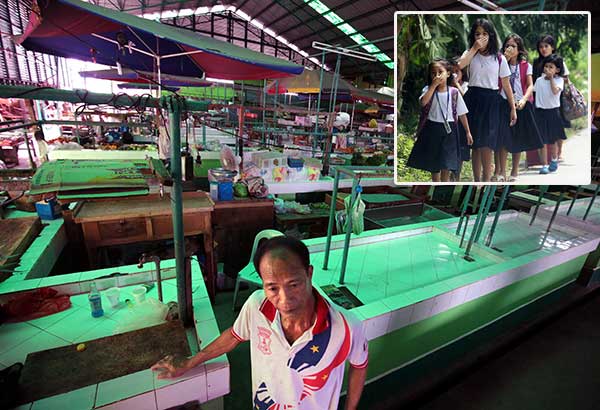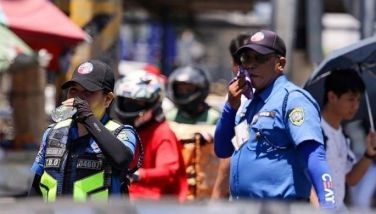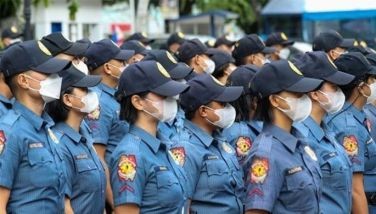Government moves to prevent bird flu jump to humans

Stalls of poultry vendors at the San Luis Public Market stand empty yesterday following an outbreak of avian flu in the town. Inset shows students of San Luis Elementary School as they walk past a poultry farm where chickens are supposed to be culled. MICHAEL VARCAS
MANILA, Philippines - Three days after confirming an avian flu outbreak, government agencies are scrambling to keep the virus from spreading and especially from jumping to humans.
Apart from the ongoing culling of thousands of chickens and ducks and quarantine of an area in San Luis town in Pampanga where the outbreak was first reported, the government is launching a nationwide inspection of poultry farms.
Agriculture Secretary Emmanuel Piñol said his department, through the Bureau of Animal Industry (BAI), has organized a biosecurity team to conduct the nationwide inspection.
“We will start as soon as possible. We will start with the farms surrounding San Luis,” he said.
The BAI is still waiting for the results of laboratory tests in Australia to determine whether the avian flu strain found in San Luis could affect humans. The results may be out within two weeks.
Dr. Arlene Vytiaco, head of BAI animal disease and control division, told The STAR in Sto. Tomas, Pampanga that earlier findings of the Philippines’ Research Institute for Tropical Medicine, that the bird flu in San Luis was not of the H5Ni strain that affects humans, were not conclusive.
Vytiaco said only the results from Australia could definitely confirm the findings.
She said workers tasked to gather fowl in the quarantine zone were thus required to wear masks and special vests.
“We have also assigned only one person from the municipal government to oversee the culling of fowl in the quarantine zone so that only he could be quarantined for 10 days,” she said.
There are currently 11 checkpoints and over 90 quarantine officers in the vicinity of San Luis.
At Malacañang, presidential spokesman Ernesto Abella assured the local poultry industry of continued support in the face of the avian flu crisis.
“Our long term concern is to sustain and support our local poultry industry as it weathers this first-time crisis,” Abella said in a press briefing.
“We will work closely with them to eliminate this problem soon and to restore our country’s chicken exports to their premium position in international markets,” he added.
He also reminded the public that there is no indication that the avian flu strain now in the country is harmful to humans. “But we will continue to validate this and take all precaution needed,” he pointed out.
The government, through the Department of Agriculture (DA), has also banned the movement or transport of birds, fowl or their byproducts from Luzon to the Visayas and Mindanao.
Transport within Luzon is allowed but not within or from the seven-kilometer radius under quarantine in San Luis, Pampanga. Transport within Luzon would require shipping permit and veterinary health certificate.
Local government units, specifically those in Bataan, Misamis Oriental and Pampanga, have announced their own contingency measures.
But citing manpower constraints, the DA said it needs a few more days – possibly until Thursday – to finish culling more than 200,000 poultry heads as part of the government’s precautionary measure to stem the spread of the first bird flu outbreak in the country.
Piñol said only 18,685 poultry heads – chicken, ducks, quail, pigeons and fighting roosters – in San Luis in Pampanga have been culled since Saturday.
The department had earlier targeted to finish culling the fowl yesterday or three days after it announced the bird flu outbreak.
“There was a bit of delay. We have to understand that it is our first time to experience this problem. A lot of people still do not understand what should be done and how this problem will be handled. There is fear even among the workers,” Piñol said.
“Some of the workers attempted to run away even after getting immunized for the culling process,” he added.
Last Friday, the DA confirmed a bird flu outbreak that had killed close to 40,000 poultry heads and placed the province of Pampanga in a state of calamity.
Vytiaco emphasized that they had to readjust and allot five to six days to complete the culling process.
“We started Saturday afternoon with only one team and was able to cull 180 heads only. We had a full blast by Sunday with four teams covering four farms but still was not able to finish,” she said.
Piñol also said his department is allocating an initial P50 million for farmers in San Luis to help them cope with the effect of the culling of some 200,000 poultry heads.
He said the DA, through the Agricultural Credit Policy Council (ACPC), is now preparing a loan assistance package for the affected farmers.
“The ACPC will provide P25,000 loan assistance under the SURE (survival and recovery) package to farmers faced with calamity situations,” Piñol said.
“P5,000 of which will be a grant while the P20,000 will be a loan with no collateral and no interest payable in two years. They can use this once they start to rebuild their farms,” he added.
“We have to factor in the period during which the farmers will not be able to make money. Farmers whose fowl will be culled will not be able to raise in the next 90 days,” Piñol said.
He also raised the possibility of the department utilizing the quick response fund (QRF) to be downloaded through the Department of Budget and Management.
The DA has a standby QRF of approximately P500 million to P1 billion that can be utilized during calamities and disasters.
“Once you declare that it is a disaster, you can access the QRF. We have already declared a disaster. We are looking at it already,” Agriculture Undersecretary Ariel Cayanan said.
Still lucky
“We are still lucky that the bird flu outbreak is not the type that will devastate the local poultry industry. It would have been a different story if the broilers were the ones affected,” Piñol said.
“It is also a relief that none of the farm workers and owners within the declared ground zero have shown any indication that they have fallen ill,” he added.
A majority of the affected birds are layered chickens, which produce table eggs. Nine commercial layer farms, four quail farms and four duck farms have been affected.
In San Luis, there are 116,000 layered chicken heads representing a minimal three percent of the total population in Pampanga. The province comprises 12 percent of national production.
In terms of broilers or chickens consumed as meat, San Luis produces 99,000 heads, or 18 percent of the whole Pampanga. The province takes up seven percent of the country’s production.
The DA chief said he is ready to resign if the bird flu virus spreads outside Luzon.
The dreaded avian influenza virus had long spared the Philippines since resurfacing in Asia in 2003.
Safe to eat
Assuaging public fears, Department of Health (DOH) Assistant Secretary Eric Tayag said poultry products infected with the avian flu virus are safe to eat if fully cooked.
Tayag gave the assurance in an interview with reporters at the House of Representatives where he attended a hearing on the DOH budget for next year.
“In other countries where there was bird flu, eating chicken did not cause illness. It’s safe to eat chicken in our country because we cook chicken,” Tayag said.
Following confirmation of the bird flu outbreak that placed the province of Pampanga in a state of calamity, the government placed a seven-kilometer radius around San Luis town under quarantine.
Santo Tomas Mayor Johnny Sambo met with poultry raisers yesterday morning to discuss the effects of the avian flu case on the local poultry industry.
Sambo said poultry owners were complaining about their products getting rejected even by regular customers or deliveries getting blocked in many provinces.
He emphasized his town is outside the seven-kilometer radius from the avian flu zone in San Luis.
The DA earlier barred the transport of live and frozen poultry even within the quarantine area. It also prohibited the delivery of Luzon poultry products to the Visayas and Mindanao.
Vytiaco said the policy being implemented by the DA is in accordance with the Philippine Avian Influenza Protection Program developed at the height of the outbreak in 2005 of the Highly Pathogenic Avian Influenza (HPAI) in Southeast Asia.
Right information
As reports on avian flu in the country continue to worry poultry raisers and consumers, Vice President Leni Robredo said the government should continue to provide the people with accurate information to avoid panic as well as protect the livelihood of many Filipinos.
“I pity our constituents who are into this business. We must be clear in giving information because fears could not only affect health but livelihood as well,” Robredo said over the weekend.
The Vice President said well informed people would not easily panic and would know how to deal with specific circumstances.
Bureau of Customs Intelligence and Investigation Service director Neil Anthony Estrella said that they would verify information that the avian flu virus in Pampanga might have come from Peking duck from China smuggled to the Philippines through Subic. With Delon Porcalla, Evelyn Macairan, Helen Flores, Paolo Romero, Alexis Romero, Cesar Ramirez, Gerry Lee-Gorit, Ric Sapnu
- Latest
- Trending
































